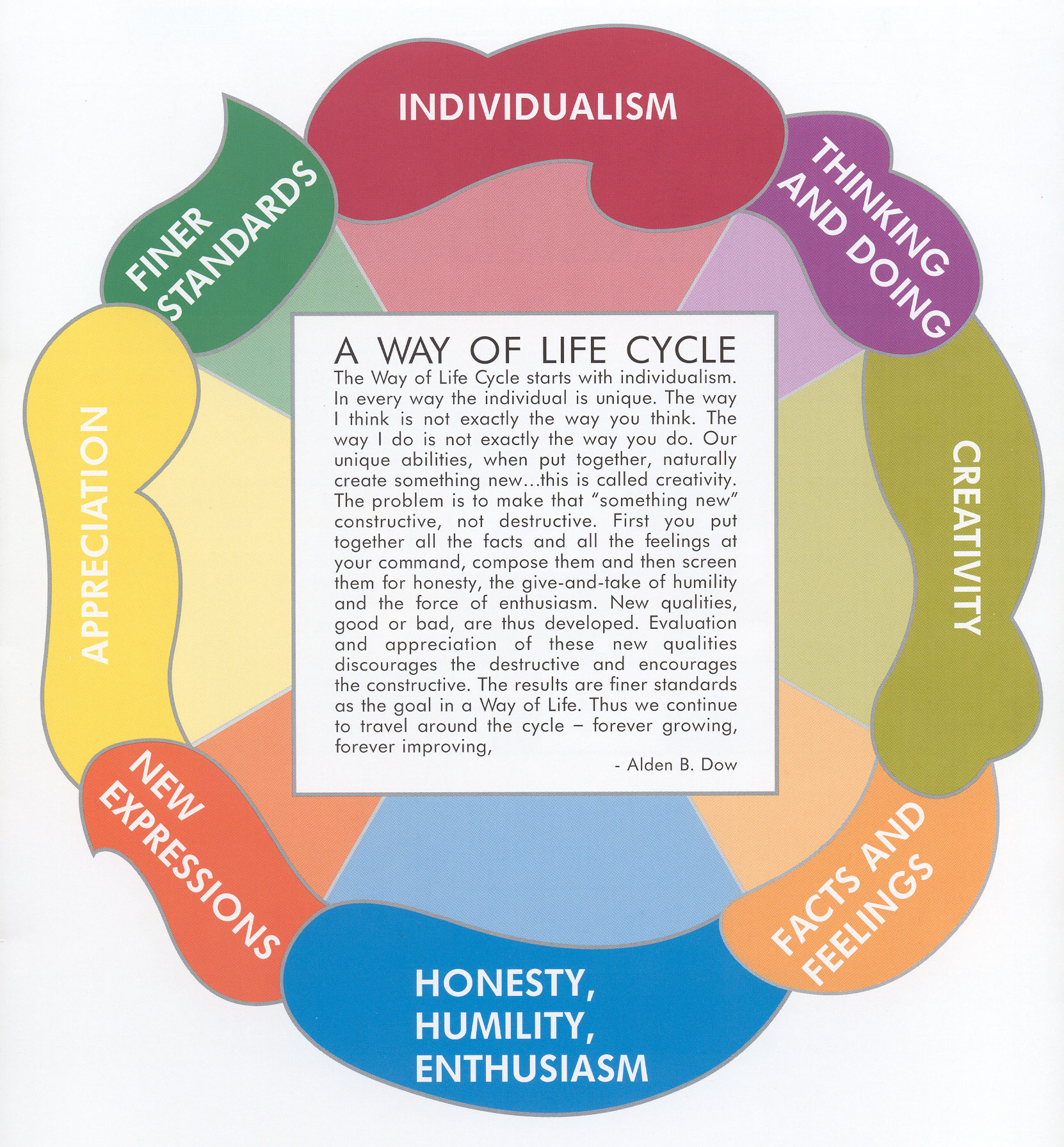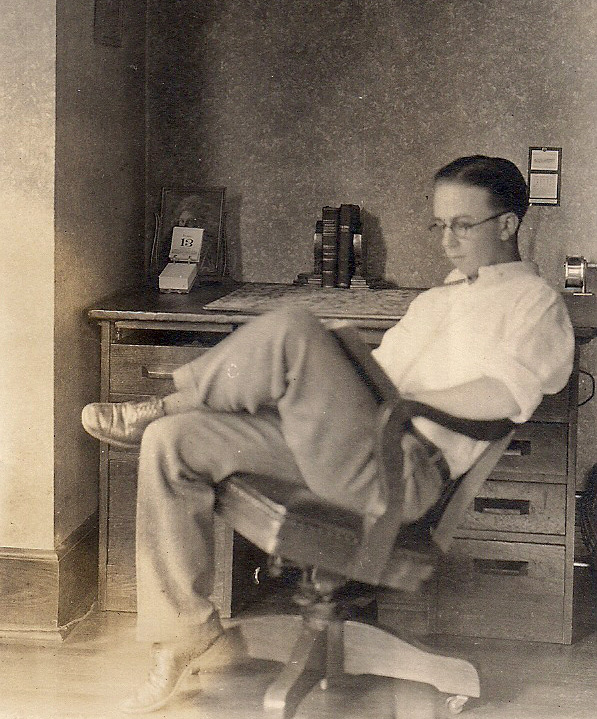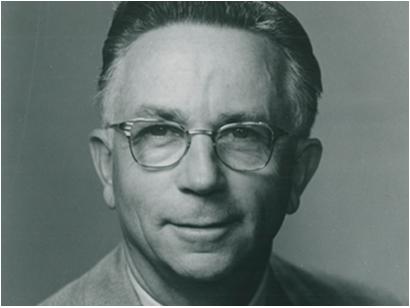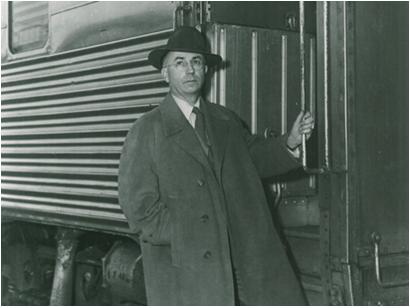About
Alden B. Dow
1904-1983
Alden B. Dow sought to create quality in all that he did. Whether designing a building, talking to a friend or spending time with his family, quality was a constant. “Each idea must be an expression of intimate care, a personal concern that all the details of the ‘Big Idea’ meet a standard of quality.” To obtain quality, he questioned, challenged and tested the world in a positive and constructive manner with honesty, humility and enthusiasm. These three factors became the guiding principals in all areas of his life, personal and professional.
The son of Herbert and Grace Dow, he graduated from Midland High School. After visiting Japan, where he stayed in Frank Lloyd Wright’s Imperial Hotel, in 1923 he attended the University of Michigan to study engineering in preparation to enter his father’s company, Dow Chemical. But after three years, Dow left to study architecture at Columbia University and graduated in 1931.
Dow married Vada Bennett in 1931. Bennett, a daughter of Earl Bennett (an employee at Dow). After a year and a half of working with the architectural firm of Frantz and Spence in nearby Saginaw MI, Alden and Vada studied with Frank Lloyd Wright at Taliesin in Spring Green WI in the summer in 1933. After that, he opened his own design firm in 1934. He received the Diplome de Grand Prix at the 1937 Paris International Exposition for his own studio as well as the John Whitman house. Dow was named the architect laureate of Michigan in 1983, shortly before his death.
Alden B. Dow was a man of his time, but created realities in architecture of the future. Innovative building practices merged with new, undefined materials allowing him to explore and create new solutions in architecture. By designing structures that reflected the way we truly live as humans, he created spaces that not only nurture and comfort us, but also awaken our minds and help us to develop our own individual creativity. His is a legacy that challenges us to look, examine and question the world, in the focused pursuit of the quality of life.
Family History
From his formative years as part of a large mid-western family that appreciated and revered education, to the challenges of living through and raising a family during the Great Depression and World War II, Dow was always focused on quality as a guide to all aspects of his life. A loving and devoted husband and father, Dow was happiest when at his home in Midland with his family and friends.
Simple Pleasures
A roadside picnic, a boating trip in the North Channel of Lake Huron or a playful and imaginatively conceived 16mm movie acted and filmed with those dearest to him, he knew the importance of sharing the simple pleasures of life with others.
Family Matters Most
Although work was a great passion for Dow, it was his wife Vada, their three children and their families that created the joy in his life that allowed him to flourish as a unique and creative individual.
Innovator
In 1972, Alden B. Dow stated, “The importance of a good, new idea lies mainly in its ability to accept improvements.” He believed when you have a new idea, you pour all your energy into it. As his father, Herbert Dow stated, “Ideas are a matter of attitude, if you took the position in looking at anything as if it were just the thing you needed, ideas would follow.” (Ways of Expressing Oneself II- unknown date)
Alden Dow developed products and innovative design elements, many of which were patented. Some of these innovative ideas related to his architectural career while others related to the social and playful aspects of life. Part of his process in developing a new idea or product was to test and challenge it from all vantage points. Not afraid of failing, Alden Dow was free to think and develop new ideas to make them the best they could be.
Below is a list of just a few of the innovative products and ideas that you are able to research in the Alden B. Dow Archives:
- Boat Steering Mechanism
- Dispensing Container
- Plastic Windows
- Railway Crossing Signal
- Stud for Combining Building Sandwiches
- Sandwich Panel Construction
- 1940’s Solar Construction
Unit Blocks
USA Patent Application, November 21, 1935; USA Patent granted, January 4, 1938.
Alden Dow’s exploration of block construction began after he graduated from the Columbia School of Architecture in 1931 and his eight-month apprenticeship at Taliesin in 1933. Inspired by nature’s patterns, he wanted a workable block with bold geometric shapes. Alden Dow, along with one of Frank Lloyd Wright’s former and finest draftsman, Robert Goodall, created a rhomboid block with a square face in 16 different sizes. One horizontal course has blocks angled to the right and the following course of blocks angles to the left producing structural integrity by its overlapping seams. This became known as Alden B. Dow’s Unit Block building system.
Alden Dow utilized this Unit Block system in many of his early designs including his own home and studio. In addition to structural support of exterior walls, the versatility of the blocks extended to interior spaces as well – table bases, level changes, division of spaces, columns – to create artistic, visual interest. He even positioned the Unit Blocks like stepping stones across the pond, farther and farther apart as they escape from the disciplined grid of the building.
In addition to their unique shape and structural integrity, the other identifying characteristic of the Unit Blocks was that they were made of the cinder that he saw piling up outside The Dow Chemical Company furnaces. His father, Herbert Dow, had utilized this same cinder to construct “clinker” bridges in their family gardens. Alden liked the idea of utilizing these resources that most people viewed as waste materials. Today, he would be thought of as an early recycler!
Alden Dow would eventually design and build a total of 13 Unit Block structures including the 1937 Grand Prix Award winning John Whitman residence (1935), before moving onto different materials.
Fur Housing
Amid the energy crisis of the late 1970’s and relatively late in his career, Alden Dow became concerned about the high cost of energy and people’s ability to afford it. He wanted to develop a siding that had superior insulating qualities, thus reducing the amount of energy structures demanded. With great tenacity, Dow tackled this problem with limitless zeal. When questioning the best insulation he knew of to date, he turned to fur. With a great amount of interaction with senior research scientists at The Dow Chemical Company, he began working on a fur siding. First discussed for the Administration Building at the University of Michigan (1964), the fuzzy siding was meant to be self-cleaning and useable for cooling as well as heating. Discussion and research went into what type of fur had the best properties to withstand changes in temperature and differing degrees of humidity, moisture and mildew. Animals replace their coats, but Alden Dow, to his great regret, could not find a way to make a building replace its “coat”. Although he was granted patents in Belgium, Canada, Great Britain, Italy and Switzerland, the siding was not successful, nor ever manufactured. But the level of research that went into the project proved Dow’s belief that when you have a good idea, you exhaust every possible avenue to prove it could work or to come to the conclusion that you needed to start anew.
Philosopher
Later in life, Alden B. Dow was asked how he wanted to be remembered and he replied, “…for my philosophy.” His philosophy, A Way of Life Cycle, focused on his belief that every human is creative. He believed if every human is allowed the freedom to develop and grow their own unique, innate gifts, they will find limitless results to offer the world. As he stated, “Everyone has creative ability. When a person is awakened to that fact in himself; all kinds of creative things can happen.” A Way of Life Cycle is the culmination of over 40 years of developing and refining his philosophy. This philosophy was not just words on a piece of paper used to impress and delight those who read it. These are words he lived by; they defined him, his actions and his work.





